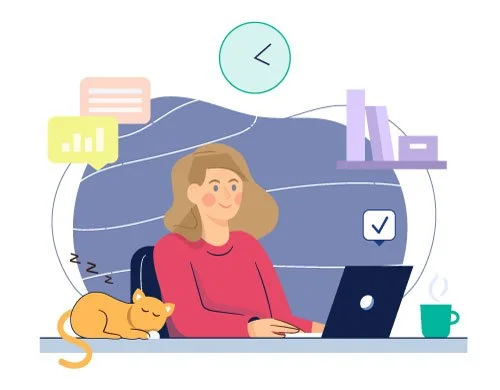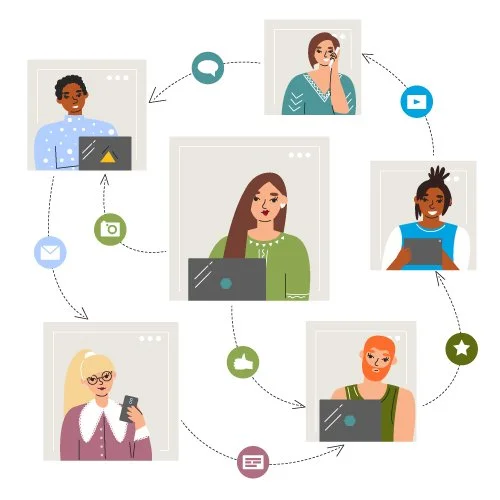READY, SET, GO!
I dove right in on the first module of the bootcamp. It was a well-thought-out progression of Storyline tutorials and mini-projects infused with adult learning theories and instructional design best practices. I found it difficult to tear myself away from the computer at night.
Living and Breathing Instructional Design
I made this transition my number 1 priority outside of school contract hours. I listened to podcasts all the way to school and back (90 minutes round trip). I grabbed my water and a snack and closed myself in our home office for the rest of the day. My husband was amazingly supportive throughout this process. He was already used to my late nights of grading and lesson planning, and he willingly took over the majority of the household duties. He even occasionally delivered dinner to me! He was impressed with my self-discipline and determination, but the truth was I loved every minute of what I was learning, and the closer I got to completing the bootcamp the more energized I became.
I followed the general the bootcamp timeline, but I took a lot of detours to explore topics from podcast episodes or enrich my knowledge of certain concepts learned in the bootcamp. I looked into every resource mentioned or recommended. I decided to purchase a year of Articulate 360 because it is the single most important tool for an aspiring instructional designer, and Articulate offers a 50% discount for teachers. I also noticed that the Adobe Creative Suite was mentioned in a majority of the Instructional Designer job postings. Since Adobe offers a 50% discount for teachers too, I purchased it while I still had access to my school email. Early on in my bootcamp projects, one of my first detours was to learn Adobe Illustrator so that I could create custom images from vector drawings. I found the Envato Tuts+ YouTube Channel particularly helpful.
Other detours included accessibility, gamification, pervasive learning, designing for behavior change, and AI in instructional design to name a few. I delved into some topics in more depth than others. Just knowing more about them helped to inform my work in the bootcamp and overall understanding of the industry. I began following industry leaders, organizations, and companies on LinkedIn, which gave me a great sense of the latest trends and hot topics to explore. I believe I started with Karl Kapp and Michael Allen. It’s energizing to listen to people like that who are so passionate about the art and science of instructional design and who are committed to sharing with others.
Reading Myself to Sleep
My reading list included Accidental Instructional Designer, Designing Accessible Learning Content, and Talk to the Elephant. I love to read, but with the hours I was keeping I confess I spent more time re-reading chapters after falling asleep somewhere mid-sentence.
Other Detours
I took detours to explore recommended resources used by instructional designers, and I subscribed to a few I felt would be most helpful while working on my portfolio. In addition to learning Adobe Illustrator on the side, I also took time to learn a few other apps in the Adobe Creative Suite like Photoshop, Premiere, and Audition. I spent a lot of time learning Vyond because I knew I wanted to use it in the featured project for my portfolio. Once my main project was complete I learned Camtasia because I was seeing it in so many of the current job postings. I took a little time to practice with Survey Monkey, collecting data for analysis; and I signed up for free trials of a few different popular learning management systems to practice uploading courses and get familiar with the various settings.
Deep Dive
I’ve always been passionate about accessibility in learning. Severe dyslexia, deafness, Asperger’s, and visual impairments all run in my family; and I have battled with ADHD my entire life. Often people think of closed captions, font size, and color contrast when considering accessibility, but there is so much more to think about!
I remember years ago helping my son, who has Asperger’s and struggles with inferences in written language, with a practice written driver’s test, The multiple choice question asked what a driver should do if the lights of an on-coming car were blinding them. My son insisted that none of the answer choices were correct. The answer was obvious to me… “Look to the right side of the road.” My son pointed out that you should never take your eyes off the road, so that couldn’t possibly be the answer.
While I have always loved to read, thanks to ADHD I have also been a slow reader. I find myself re-reading sentences because I hadn’t processed their meaning. Maybe it was a noise that drew my attention - someone rustling papers, clicking a pen, or talking in the distance. Maybe it was a visual distraction - a color on the page, someone walking by, or too many spaces between words on a line. You may think sound-canceling headphones and isolation would do the trick, but that’s when my mind can wander with no prompting at all. Books on tape help a bit, but I’m still rewinding frequently because I realize I have no idea what the last paragraph was about.
Authoring tools have built-in accessibility features, but they are still limited and they don’t address most learning differences. It is the responsibility of the learning experience designer and developer to consider how layout, color, background music, automatically playing audio and video, and time limits among other elements may affect the learner’s experience. This is the reason I invested in Susi Miller’s book, Designing Accessible Learning Content.
Section 508 compliance is mentioned often in job postings. I learned in a podcast episode that the government had a free Trusted Tester Certification course. Not only was I interested in learning the content, but I knew the certification would help me stand out amongst other applicants. I learned how to use the official accessibility tools to determine the accessibility of digital content, including ANDI and the Colour Contrast Analyzer, and I gained a lot of insight into the importance of each Section 508 guideline. However, before you run out and enroll in the course, know this: The assessment portions of the course are clearly NOT designed by anyone with any sort of knowledge or skill in creating quality assessments! I spent more time trying to figure out what the test was asking for. There is a forum for people to ask questions and get support, but it is filled with post after post by people at their wit’s end, trying to understand why answers were marked incorrect. I don’t think it is a coincidence that they were all struggling with the exact same questions either. On top of that, I used the test tools to practice assessing 508 compliance for the Trusted Tester course pages within the Department of Homeland Security website, and every one of the pages failed. I completed the course but quit without the certification. I did not have the time to waste on figuring out the thought process (or lack thereof) behind every question in the final exam.
Community Participation
When first starting out in the bootcamp, I was extremely self-conscious about posting anything in the bootcamp or other ID communities. I joined a Storyline 360 group on Facebook, GLDC, and the Articulate eLearning Heroes Community. The more I immersed myself in the conversations, the more ingrained the language became. Back at school, I began referring to students as “learners” and parents and admin became “stakeholders.” In the Devlin Peck ID Bootcamp, you are encouraged to join a small group team of other bootcampers to meet with, and I highly recommend it. It is a safe space to ask questions and practice giving and receiving feedback on projects. The more people that are willing to share their work the more everyone learns, and there is no such thing as “bad” feedback. The goal is creating learning experiences for a spectrum of individuals - not just other IDs, so the more perspectives you can get the better your courses will be for everyone.
Devlin Peck also encourages bootcampers to partner up with a bootcamp buddy, and I believe I got the most out of this partnership. I found 2 equally passionate bootcampers also looking for a buddy, so I started meeting with each of them separately every week. We took turns helping each other, providing feedback, and sharing any new learning.
Long Haul
I had my sights set on being gainfully employed by the end of the summer, which is also when I was scheduled to complete the 5-month bootcamp. Working around the clock, I was confident I could finish in 4 months or less. However, the detours to enrich my learning and get involved in the community were totally worth the extra month of work.
When I say “around the clock”, I mean weekends as well. I was living and breathing instructional design, and burnout reared its ugly head more than once. Usually, I was able to avoid it by changing my focus for a while, but I did allow myself to completely disengage for a day here and there before getting right back on track.





